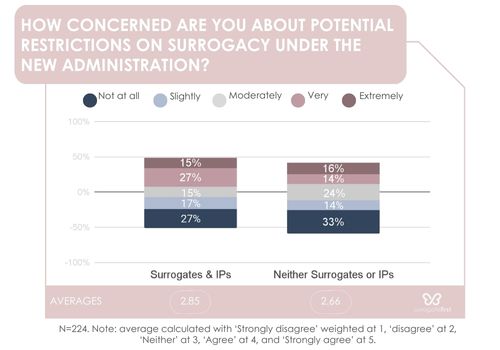

The landscape of surrogacy and family-building policies in the United States is undergoing significant transformation, driven by evolving legal, economic, and social factors. With the recent 2024 election, new regulatory shifts and state-specific policies have introduced heightened uncertainty for both surrogates and intended parents. These changes have influenced everything from surrogate availability and contractual agreements to the financial feasibility of surrogacy, prompting a reassessment of best practices within the industry.
As these developments unfold, understanding the perspectives of surrogates, intended parents, and the broader public is crucial for navigating this complex environment. This research examines public perceptions, policy impacts, and financial factors shaping surrogacy in the U.S.
All data and insights in this report come from an online survey conducted from March 17 to March 25, 2025, with 224 respondents: 31 surrogates, 10 intended parents, and 183 others (all U.S. citizens aged 18–65).
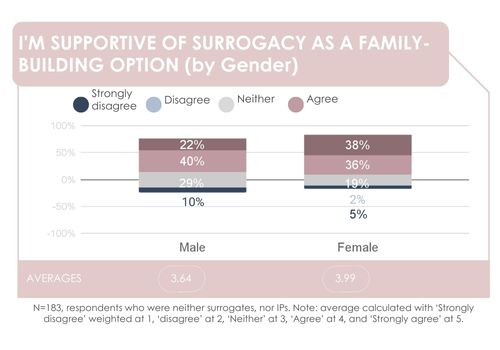
Support for surrogacy as a family-building option is exceptionally strong among direct stakeholders — surrogates and intended parents, with 100% expressing strong agreement. The majority of the general population is also supportive, though with less intensity: 31% strongly agree, 37% agree, while nearly a quarter (24%) remain neutral.
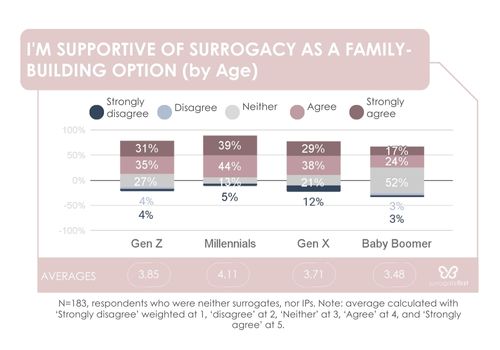
Support for surrogacy as a family-building option is exceptionally strong among direct stakeholders — surrogates and intended parents, with 100% expressing strong agreement. The majority of the general population is also supportive, though with less intensity: 31% strongly agree, 37% agree, while nearly a quarter (24%) remain neutral.
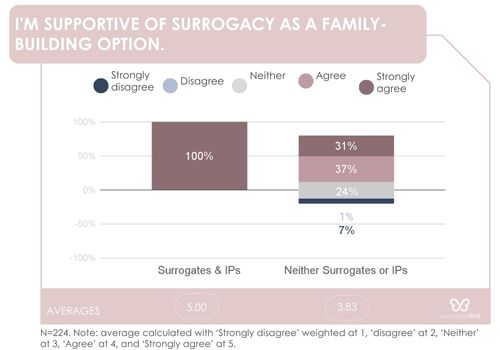
Women are more likely than men to strongly support surrogacy (38% vs. 22%), while men are more often undecided, with nearly one-third selecting “neither agree nor disagree.”
When asked if they would consider surrogacy as a path to parenthood in case of infertility, surrogates and intended parents showed strong support, with 90% of IPs and 80% of surrogates agreeing or strongly agreeing. Among the general public, a majority (58%) would also consider this option; however, uncertainty remains higher in this group, with 22% undecided and 19% expressing disagreement.
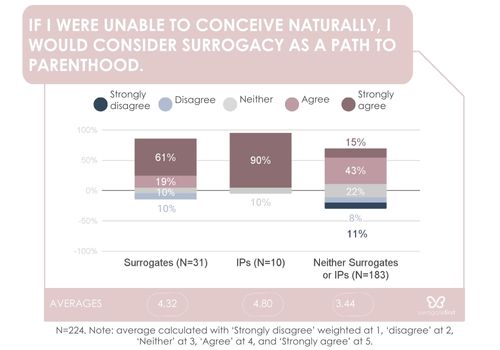

Support for the legality of surrogacy is strong and consistent. Among surrogates and intended parents, opposition to outlawing surrogacy is unanimous, while 75% of the general public also disagree with a ban. Only 5% of the general public explicitly support outlawing surrogacy, with the remaining 20% undecided. Most people, even outside of direct involvement, lean toward support or remain open to the practice.
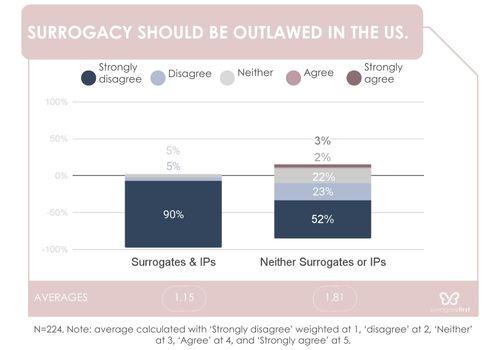
While support for the legality of surrogacy is undoubtful, views on whether it should be limited to medical reasons, such as infertility, rather than for convenience, are more divided. Among surrogates and intended parents, 36% strongly disagree or disagree with this limitation, while 39% strongly agree or agree that surrogacy should only be allowed for medical reasons. In the general public, the opinions are similarly mixed, with 37% strongly disagree or disagree and 35% strongly agreeing or agreeing that surrogacy should be allowed for medical reasons. While support for surrogacy is clear, there is no consensus on restricting its use to medical necessity.
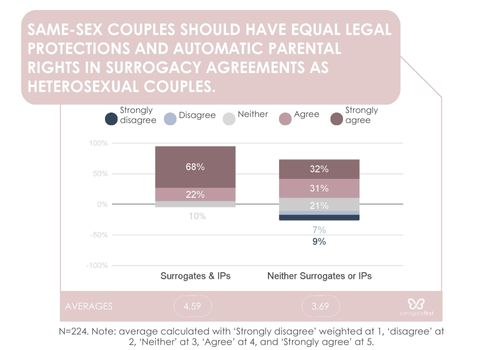
90% of surveyed surrogates and IPs agree or strongly agree that same-sex couples should have equal legal protection and automatic parental rights in surrogacy agreements as heterosexual couples. However, the general public shows more divided views, with 63% in favor, but 16% believing that same-sex couples should not have the same legal protections and parental rights as heterosexual couples.
Surrogates and intended parents demonstrate overwhelming support for the idea that surrogacy should be legally accessible to all individuals, including LGBTQ+ parents and single parents, with 93% strongly agreeing or agreeing. In contrast, the general public shows more mixed views, with 61% expressing agreement and 17% strongly disagreeing or disagreeing.
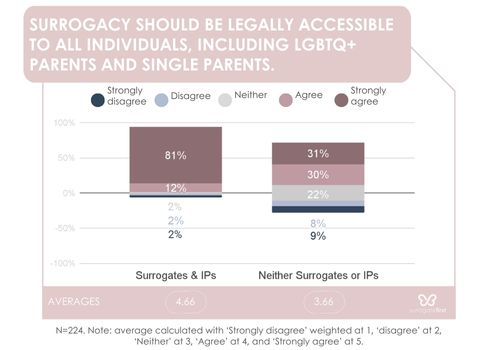
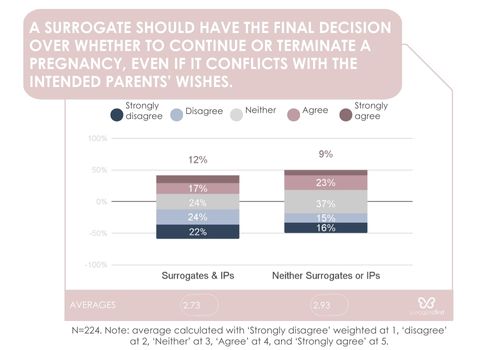
Views on whether a surrogate should have the final say in continuing or terminating a pregnancy, even if it conflicts with the intended parents’ wishes, are similarly divided between surrogates and intended parents and the general public. Among surrogates and IPs, 46% disagree or strongly disagree, while 29% agree or strongly agree. The general public shows similar split, with 31% in agreement and 31% in disagreement, while a large share — 37% — remain neutral.
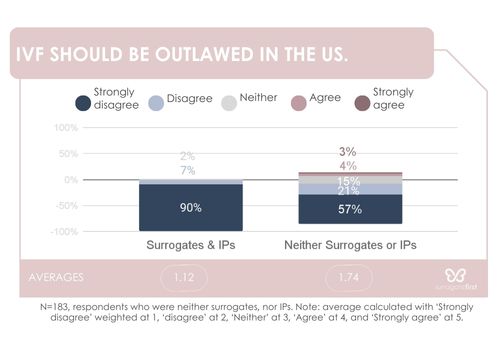
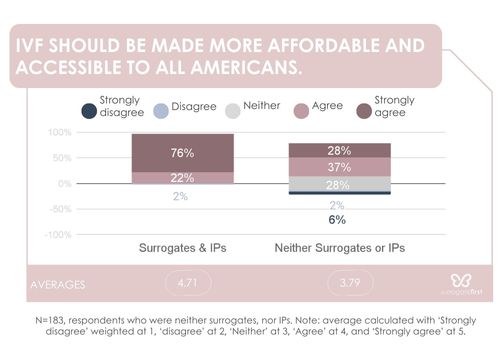
A majority of surrogates and intended parents (68%) oppose outlawing abortion in the U.S., with 51% strongly disagreeing. The general public shows a similar trend, with 59% opposed and 42% strongly disagreeing. Support for banning abortion remains relatively low across both groups—just 14% of surrogates and IPs and 22% of the general public agree or strongly agree—though that still represents a significant portion of respondents.
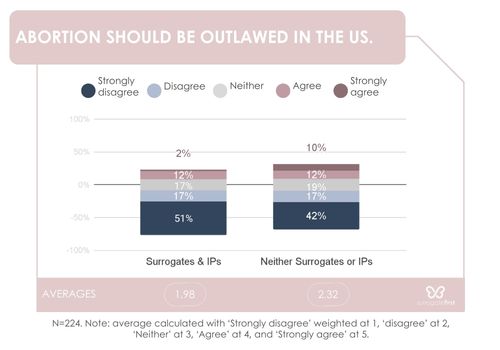
There is strong consensus that IVF should not be outlawed. An overwhelming 97% of surrogates and IPs and 78% of the general public disagree or strongly disagree with banning IVF. Support also runs high for making IVF more affordable and accessible: 98% of surrogates and IPs agree, including 76% who strongly agree, while 65% of the general public also agree or strongly agree, signaling broad recognition of the importance of IVF as a family-building option.
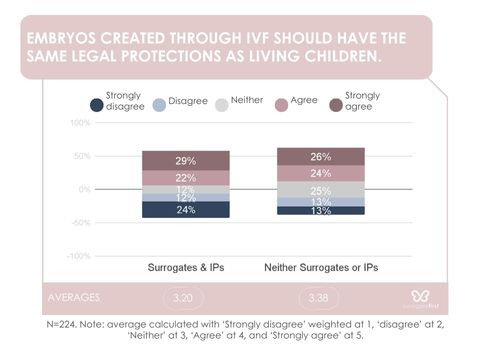
Views on whether embryos created through IVF should have the same legal protections as living children are divided. Among surrogates and intended parents, 36% disagree or strongly disagree with this idea, while 51% agree or strongly agree. The general public shows a slightly more moderate stance, with 26% disagreeing, 50% agreeing, and 25% remaining neutral. There is no clear consensus on granting embryos full legal status equivalent to living children.
Intended parents — those directly involved in pursuing fertility services — were the most likely to report that inflation and rising costs have negatively impacted their ability to access treatments like IVF and surrogacy. Nearly 90% of intended parents agreed or strongly agreed with this statement, with 67% strongly agreeing. In comparison, only 39% of the general public and 39% of surrogates expressed the same concern, with a significant portion in both groups remaining neutral.
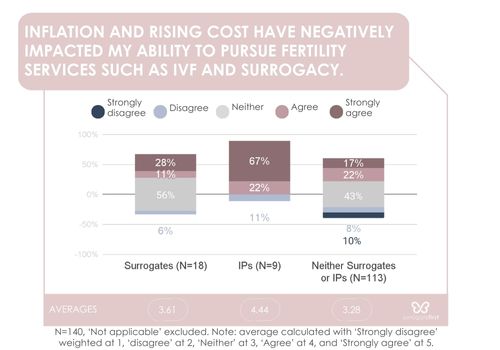
Support for requiring health insurance to cover surrogacy-related medical expenses is significantly higher among surrogates and intended parents compared to the general public. A strong majority of surrogates and IPs (88%) agreed or strongly agreed with this policy, with 59% expressing strong agreement. In contrast, views among the general public are more mixed—only 51% agreed or strongly agreed, while 24% disagreed, and a notable 25% remained neutral. This gap highlights the difference in perspective between those directly involved in surrogacy and those who are not.
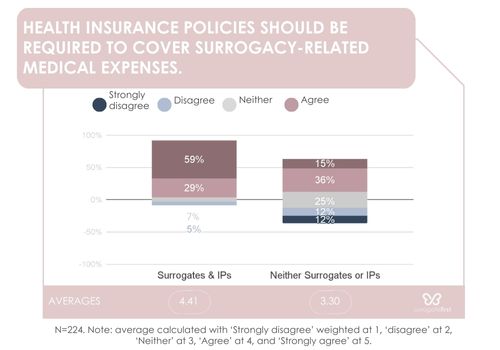
Support for requiring health insurance to cover surrogacy-related medical expenses is significantly higher among surrogates and intended parents compared to the general public. A strong majority of surrogates and IPs (88%) agreed or strongly agreed with this policy, with 59% expressing strong agreement. In contrast, views among the general public are more mixed—only 51% agreed or strongly agreed, while 24% disagreed, and a notable 25% remained neutral. This gap highlights the difference in perspective between those directly involved in surrogacy and those who are not.
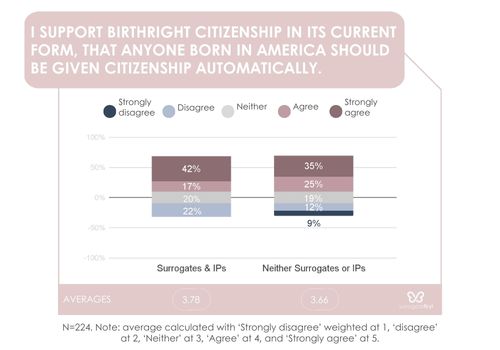
Surrogates and intended parents show less support for government intervention in surrogacy compared to the general public, where opinions are more mixed. Among surrogates and intended parents, 56% either strongly disagree or disagree with government regulation of surrogacy, while only 5% strongly agree. In contrast, the general public is more divided, with 33% remaining neutral, 30% supporting regulation, and 37% opposing it.
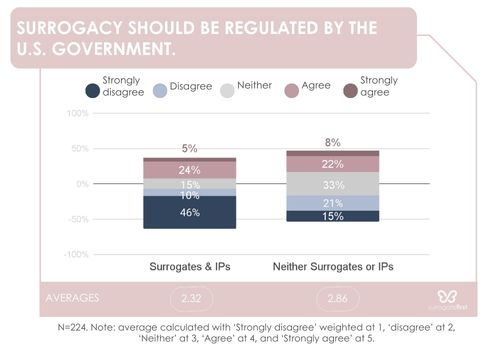
Under the new administration, multiple policies have been signed that could influence the landscape of surrogacy. Surrogates and intended parents show a higher level of concern compared to the general public regarding these policies. 41% of surrogates and intended parents express varying degrees of concern, with 27% being very concerned and 15% extremely concerned. In contrast, only 28% of the general public share similar concerns, with a significant portion, 33%, expressing no concern at all.
